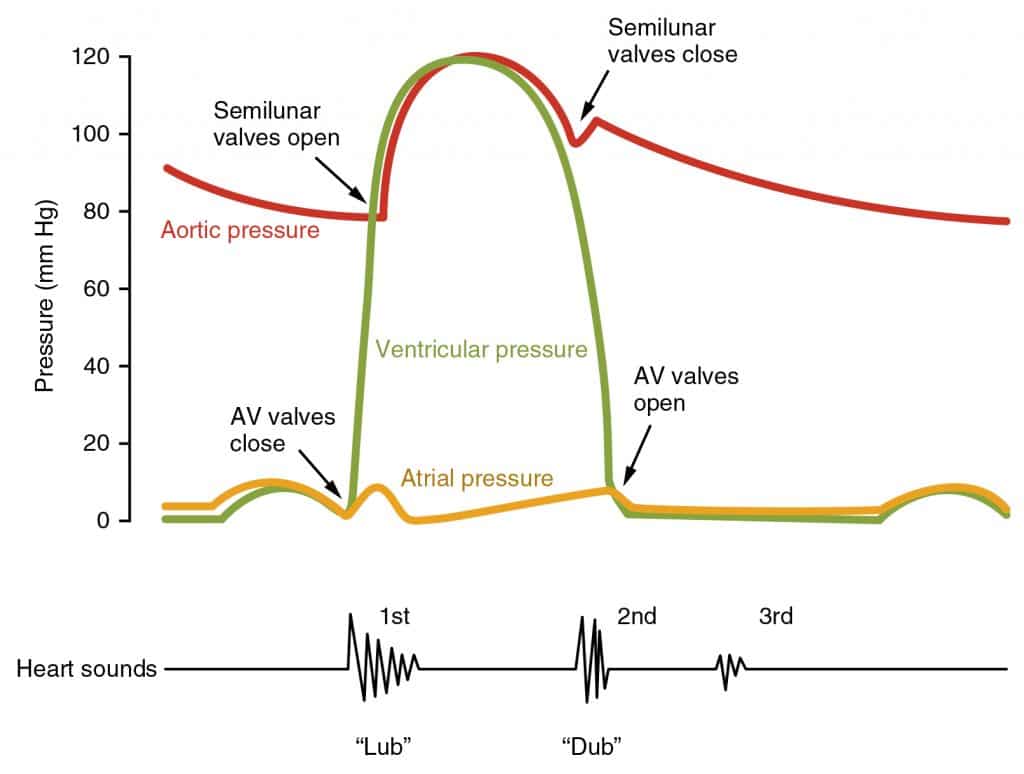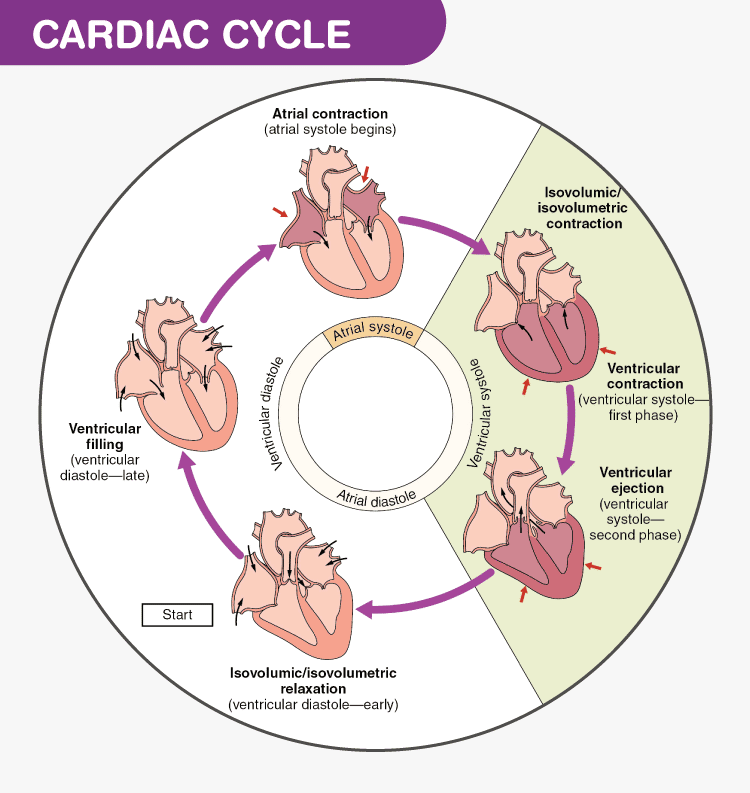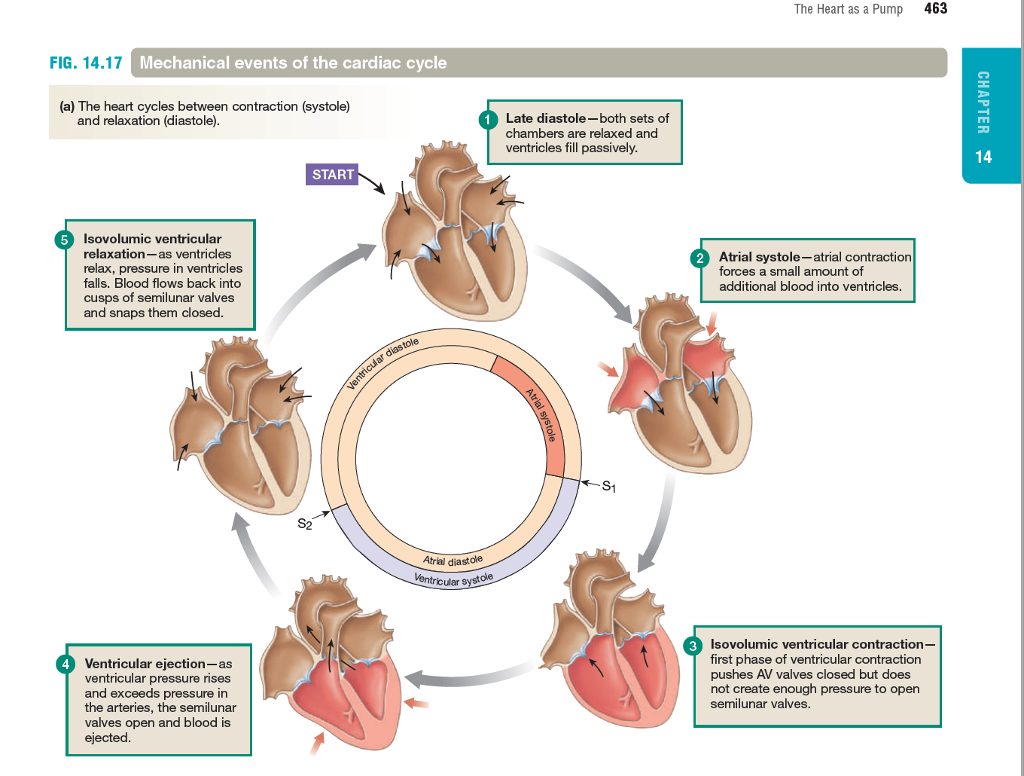Each part of the cardiac cycle consists of several phases characterized by either. The ventricular diastolic stage involves blood flow from the atria to the ventricles and the ventricular systole includes blood flow from the ventricles to the pulmonary artery and the aorta.

The Cardiac Cycle Pressures In The Heart Teachmephysiology
This is followed by a relaxation phase diastole where the heart.

. The cardiac cycle describes all the activities of the heart through one complete heartbeatthat is through one contraction and relaxation of both the atria and ventricles. The atrioventricular valves - left mitral and right tricuspid - prevent regurgitation of. The period of contraction that the heart undergoes while it pumps blood into circulation is called systole.
Cardiac cycle phases Atrial diastole. Consists of 2 phases. Mechanical events of the cardiac cycle 1Atrial systole.
The cardiac cycle is a series of electrical and mechanical events that occur during the phases of heart relaxation diastole and contraction systole. The blood is forced into the ventricles as the bicuspid valves are open. The cardiac cycle has 3 stages.
Diastole is defined as the phase in which the heart especially the ventricles is at rest. It is initiated by spontaneous generation of action potential in SA sinoatrial node. The successive events of the cardiac cycle are briefly described as below.
Ventricular filling occur during diastole. It comprises diastole the systole and the intervening pause. The period of time that begins with contraction of the atria and ends with ventricular relaxation is known as the cardiac cycle.
Ii Beginning of Ventricular Systole The contraction of ventricles begin due to the wave of. Some events of cardiac cycle are as follows. It occurs some milliseconds before the.
As the heart beats it circulates blood through pulmonary and systemic circuits of the body. The human heart beats over 100000 times per day. In each cardiac cycle the heart contracts systole pushing out the blood and pumping it through the body.
The cardiac cycle is the series of contractions in the heart that pressurize different chambers causing blood to flood in one direction. The occurrence of a cardiac cycle is illustrated by a heart rate which is naturally indicated as beats per minute. The period of time that begins with contraction of the atria and ends with ventricular relaxation is known as the cardiac cycle Figure.
The cardiac cycle The cardiac events occur from the beginning of one heart beat to the beginning of next heart beat. A contraction event of either the atria or ventricles is referred to as systole. There are 2 main phases to the heart cycle - diastole and systole.
Learn vocabulary terms and more with flashcards games and other study tools. Both the atria and ventricles undergo systole and diastole and it. The period of relaxation that occurs as the chambers fill with blood is called diastole.
The sequence of electrical and mechanical events occurring in the heart during a single beat. This activity guarantees flow of a significantly large amount of blood to tissues and lungs enhancing the overall effect of systemic and pulmonary circulation. A period of relaxation known as diastole and a period of contraction known as systole.
Start studying describe the events of a cardiac cycle. The cardiac cycle is the sequence of events that occurs when the heart beats. It consists of two parts.
I Atrial Systole The atria contract due to the wave of contraction stimulated by the SA node. The cardiac cycle refers to all of the events that occur from the beginning of one heartbeat to the beginning of the next and can be divided into two parts. Systole is defined as the phase in which the heart especially the ventricles is contracting.
Outflow phase the ventricles continue to contract pushing blood into the aorta and the pulmonary trunk. The contraction of the heart muscles called systole and the relaxation period known as diastole. There are two phases of the cardiac cycle.
Ventricular relaxation called. Both the atria and. The relaxed heart allows for blood to fill the cardiac chambers.
The muscles contract during systole pushing blood through the arteries. The cardiac cycle is a period from the beginning of one heart beat to the beginning of the next one. Duration of one cardiac cycle is O8 seconds.
The period of contraction that the heart undergoes while it pumps blood into circulation is called systole. The function of the heart valves is to prevent blood backflow inducing a unidirectional flow of blood during the cardiac cycle events. Ventricular contraction called.
Generally the cardiac cycle can be divided into two separate periods. Atrial diastole is the very first event of the cardiac cycle. Systole and diastole occur through a series of events marked by structural changes of.
There are two stages during the cardiac cycle. The period of relaxation that occurs as the chambers fill with blood is called diastole. The period of timethat begins with contraction of the atria and ends with ventricular relaxation is known as the cardiac cycle Figure 1931.
The autonomous sinuatrial node initiates an action potential that is propagated. The diastole phase and the systole phase. These events result in changes in pressure flow and volume in the various cardiac chambers.
In the diastole phase heart ventricles relax and the heart fills with blood. Atrial and Ventricular diastole chambers are relaxed and filling with blood Atrial systole atria contract and remaining blood is pushed into ventricles. The cardiac cycle attributes to a comprehensive heartbeat from its production to the commencement of the next beat.
The cardiac cycle is the coordination of the filling and emptying of the heart of blood by electrical signals that cause the heart muscles to contract and relax. Filling phase the ventricles fill during diastole and atrial systole. The period of contraction that the heart undergoes while it pumps blood into circulation is called systole.
Period of ventricular relaxation and filling. During diastole the ventricles relax and fill with blood. Period of ventricular contraction and blood ejection 2 Diastole.
The period of relaxation that occurs as the chambers fill with blood is called diastole. Isovolumetric contraction the ventricles contract building up pressure ready to pump blood into the aortapulmonary trunk.

Cardiac Cycle Physiology Diagram Phases Of The Cardiac Cycle

Solved Cardiac Cycle Can You Walk Your Way Through The Chegg Com

19 3 Cardiac Cycle Anatomy Physiology

Assessment Statements H 5 1 Explain The Events Of The Cardiac Cycle Including Atrial And Ventricular Systole And Diastole And Heart Sounds H 5 2 Analyse Ppt Download
0 Comments